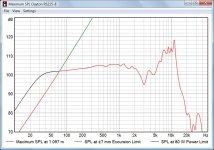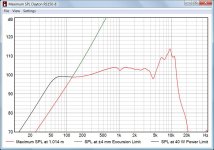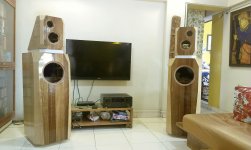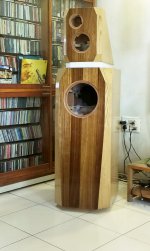Hi all,
Am starting a new project, and would welcome comments.
My initial thoughts on the Darbari are on this page.
After the Asawaris, am hoping that this will be a system I can live with for my own use (all the Asawaris have gone to friends).
This will be a three-way with Dayton RS woofer and mid, and Seas TBFC/G tweeter. Drivers were bought a few years ago. Enclosure building will start soon. Crossover has been ordered. And in case you are wondering how the hell does one order a crossover before even the enclosures have been built, please read the attachments.
Wish me luck.
Am starting a new project, and would welcome comments.
My initial thoughts on the Darbari are on this page.
After the Asawaris, am hoping that this will be a system I can live with for my own use (all the Asawaris have gone to friends).
This will be a three-way with Dayton RS woofer and mid, and Seas TBFC/G tweeter. Drivers were bought a few years ago. Enclosure building will start soon. Crossover has been ordered. And in case you are wondering how the hell does one order a crossover before even the enclosures have been built, please read the attachments.
Wish me luck.
Attachments
Well, good luck !!

There are some ( most of them ) faults in the reasoning that I found while reading the darbari project. I start from the bottom : the 6" will have an equalization like LT ?? Why ? (I would scale all the dimensions : 6 " woofer; 4" midrange and 3/4- 1" tweeter ); cone papers are floppy ? Why ? You're meaning that the cone doesn't follow the VC pistonic movement and changes in dispersion are uneven because only the very center emits the higher frequencies ? Well, paper is a very old material and of course there are better ones, but for other reasons (!?!).
) faults in the reasoning that I found while reading the darbari project. I start from the bottom : the 6" will have an equalization like LT ?? Why ? (I would scale all the dimensions : 6 " woofer; 4" midrange and 3/4- 1" tweeter ); cone papers are floppy ? Why ? You're meaning that the cone doesn't follow the VC pistonic movement and changes in dispersion are uneven because only the very center emits the higher frequencies ? Well, paper is a very old material and of course there are better ones, but for other reasons (!?!).
The reasoning at the beginning about the reproduction of the voice might be true, but also slopes of the various drivers must be considered, e.g. 80 Hz Fc having 6 dB/oct slope would still play till 300 Hz (!?). Talking about vibrations and the way to confine them to inaudible levels, the only effective one is the one I exposed in the 'floating speaker enclosure' Thread
There are some ( most of them
The reasoning at the beginning about the reproduction of the voice might be true, but also slopes of the various drivers must be considered, e.g. 80 Hz Fc having 6 dB/oct slope would still play till 300 Hz (!?). Talking about vibrations and the way to confine them to inaudible levels, the only effective one is the one I exposed in the 'floating speaker enclosure' Thread
If a driver is put in a sealed enclosure, you don't know exactly how it will behave at the bottom end of its SPL curve, and what its F3 and Q will be. One either calculates this by box modelling and accurate sizing of box to get the desired Q and F3, or one designs an approximate box size and then uses LT to get the desired Q and F3. I am doing the latter. Nothing very revolutionary there.There are some ( most of them) faults in the reasoning that I found while reading the darbari project. I start from the bottom : the 6" will have an equalization like LT ?? Why ? (I would scale all the dimensions : 6 " woofer; 4" midrange and 3/4- 1" tweeter );
After the 6" driver is fitted to the enclosure, I will take impedance measurements and get the "natural" Q and F3 of the driver in the enclosure. I will then plug these into the LT to get a Q of 0.7 and the F3 I want (I will probably go for 100Hz). This will give me a 2nd order high-pass at 100Hz. I will then add another 2nd order highpass at the same F3 to get a 4th order rolloff. As I said, nothing revolutionary here.
I think paper cones have higher second-order harmonics because they are not stiff and pistonic as much as hard metal cones. The fact that most paper cone drivers have higher low-order harmonics is quite well known, I believe.cone papers are floppy ? Why ? You're meaning that the cone doesn't follow the VC pistonic movement and changes in dispersion are uneven because only the very center emits the higher frequencies ? Well, paper is a very old material and of course there are better ones, but for other reasons (!?!).
Absolutely right. To address this, I intend to do 4th order acoustic for most of the slopes, if not steeper. This will minimise those problems, I feel.The reasoning at the beginning about the reproduction of the voice might be true, but also slopes of the various drivers must be considered, e.g. 80 Hz Fc having 6 dB/oct slope would still play till 300 Hz (!?).
In general, I don't know how people build first-order crossovers unless they are using full-range drivers. I much prefer higher-order unless I have a good reason to use lower-order slopes.
Yes, I guess such approaches are really excellent, but I am trying to get to 90% of that level with 20% of the effort.Talking about vibrations and the way to confine them to inaudible levels, the only effective one is the one I exposed in the 'floating speaker enclosure' Thread
Last edited:
You know what you are doing and I wish you luck with your 3-way project. Just a little thing to consider. Maximum excursion of the drivers limits the low frequency extension of woofer and midrange. Thus 25 Hz and 100 Hz seems to be a little optimistic, I would rather expect 40 Hz and 200 Hz. However that's still fine IMO.
Attachments
You're probably right, but the question really is about the limits at a given SPL, isn't it? I may not have problems reaching low frequency levels at 5W and 10W power outputs, where I will listen at home.Just a little thing to consider. Maximum excursion of the drivers limits the low frequency extension of woofer and midrange. Thus 25 Hz and 100 Hz seems to be a little optimistic, I would rather expect 40 Hz and 200 Hz. However that's still fine IMO.
The building of enclosures has started. The woofer enclosure has good bracing, built as a separate assembly out of 20mm plywood, and inserted into the enclosures. The side walls will be clamped tightly to the bracing using screws and Araldite.
You can see some images of bracing here. These things are pretty impressive to look at, being about three feet tall.
You can see some images of bracing here. These things are pretty impressive to look at, being about three feet tall.
Woofer box construction
The woofer enclosures are turning out well.
The front baffle is being constructed out of three sheets. I am chamfering each sheet so that the cutout for the driver widens inside the box, creating as little reflections of the back wave as possible. (I guess this will be a much bigger issue for the midrange driver than for this one, since this one will have a a high-pass at 100-150Hz.)
More details on my page here.
The woofer enclosures are turning out well.
An externally hosted image should be here but it was not working when we last tested it.
An externally hosted image should be here but it was not working when we last tested it.
The front baffle is being constructed out of three sheets. I am chamfering each sheet so that the cutout for the driver widens inside the box, creating as little reflections of the back wave as possible. (I guess this will be a much bigger issue for the midrange driver than for this one, since this one will have a a high-pass at 100-150Hz.)
An externally hosted image should be here but it was not working when we last tested it.
An externally hosted image should be here but it was not working when we last tested it.
An externally hosted image should be here but it was not working when we last tested it.
An externally hosted image should be here but it was not working when we last tested it.
An externally hosted image should be here but it was not working when we last tested it.
More details on my page here.
Last edited:
The amplifier side of things
Am aiming to use Panson Audio's compact amplifier module for my six channels of amplification. LME49811-based modules with one pair of ThermalTrak OPS devices per channel. Am hoping they will serve this application well. They are a bit underpowered for my taste -- would have loved it if they just had two pairs of OPS devices instead of one, but then I have to make do with what I am getting.
I will also be adding speaker protection and amplifier soft-start modules to the amplifiers. I am thinking of making two chassis, with four amplifier channels in each chassis. (I need three per side; the fourth will be free for now.)
When the left channel and the right channel have completely separate circuits, can one call them "dual mono", even if three amp channels share a common transformer?
Am aiming to use Panson Audio's compact amplifier module for my six channels of amplification. LME49811-based modules with one pair of ThermalTrak OPS devices per channel. Am hoping they will serve this application well. They are a bit underpowered for my taste -- would have loved it if they just had two pairs of OPS devices instead of one, but then I have to make do with what I am getting.
I will also be adding speaker protection and amplifier soft-start modules to the amplifiers. I am thinking of making two chassis, with four amplifier channels in each chassis. (I need three per side; the fourth will be free for now.)
When the left channel and the right channel have completely separate circuits, can one call them "dual mono", even if three amp channels share a common transformer?
The enclosures are almost ready.
I have yet to start work on the amplifiers. Am getting a new measurement mic (calibrated Dayton Audio mic) from Cross Spectrum Labs, and a new Behringer 302USB, for SPL measurements. Let's see how they work out. Am sure I will have to suffer a lot of pain figuring out how to configure this stack -- my old mic and USB sound card worked well but did not support XLR mic inputs, so could not use it with any of the calibrated mics available.
More details of construction on this page
An externally hosted image should be here but it was not working when we last tested it.
An externally hosted image should be here but it was not working when we last tested it.
I have yet to start work on the amplifiers. Am getting a new measurement mic (calibrated Dayton Audio mic) from Cross Spectrum Labs, and a new Behringer 302USB, for SPL measurements. Let's see how they work out. Am sure I will have to suffer a lot of pain figuring out how to configure this stack -- my old mic and USB sound card worked well but did not support XLR mic inputs, so could not use it with any of the calibrated mics available.
More details of construction on this page
The enclosures are ready. Need to start fitting the drivers now.
My carpenter disappeared a few months ago, and it took me these months to find another one who would be good enough to work on these things. I also managed to locate a good polishing guy, but he was on holiday at his native village and returned only at the end of June. He's done a good job of polishing and finishing the enclosures -- PU glossy, with five to six coats of sealer. All this took time, while I twiddled my thumbs.
The stack of two enclosures is about five and a half feet tall. I am planning to get a wedge-shaped piece made to put between the two, to make the top enclosure point downwards a few degrees.
I have postponed my plans to build my own amplification. I have acquired a Marantz SR5200 AV amplifier instead, from eBay UK. It gives me six channels of amplification of adequate quality.
Miles to go still...
My carpenter disappeared a few months ago, and it took me these months to find another one who would be good enough to work on these things. I also managed to locate a good polishing guy, but he was on holiday at his native village and returned only at the end of June. He's done a good job of polishing and finishing the enclosures -- PU glossy, with five to six coats of sealer. All this took time, while I twiddled my thumbs.
The stack of two enclosures is about five and a half feet tall. I am planning to get a wedge-shaped piece made to put between the two, to make the top enclosure point downwards a few degrees.
I have postponed my plans to build my own amplification. I have acquired a Marantz SR5200 AV amplifier instead, from eBay UK. It gives me six channels of amplification of adequate quality.
Miles to go still...
Attachments
Last edited:
Good going tarun, missed this thread before. Enclosures look great.
I don't think it's possible to totally eliminate the ringing of metal cone drivers as the generation of HD is an acoustic problem. Correcting it electrically is not a solution, IMO the only way to do it is cross over far lower than common practice, as the distortion peak is still present.
I live with a Zaph L18 every day, and I cannot notice any peak in the response. In fact it measures flat from 140 to 21Khz, on axis in 'quasi-anechoic' conditions. There is no listening fatigue, actually it sounds quite warm and smooth.
Higher order filters have their own issues, being an active does not totally eliminate all problems. I've been through this when making my active monitors, and I ifnd shallow slopes with a bit of eq and peaking control is better than trying to go for very steep slopes and no other eq. As always, this has to be based on your drivers, their breakup and the crossover point, power handling requirements, etc. I have a feeling that the best way to approach this would not be significantly different from your older project.
Also, that Marantz is not going to make you very happy, for one the total power will be severely restricted by the power supply. It may be a good bet to begin with, but even some chip amps with a decent supply would outperform it quite handily.
Good luck with your project!
I don't think it's possible to totally eliminate the ringing of metal cone drivers as the generation of HD is an acoustic problem. Correcting it electrically is not a solution, IMO the only way to do it is cross over far lower than common practice, as the distortion peak is still present.
I live with a Zaph L18 every day, and I cannot notice any peak in the response. In fact it measures flat from 140 to 21Khz, on axis in 'quasi-anechoic' conditions. There is no listening fatigue, actually it sounds quite warm and smooth.
Higher order filters have their own issues, being an active does not totally eliminate all problems. I've been through this when making my active monitors, and I ifnd shallow slopes with a bit of eq and peaking control is better than trying to go for very steep slopes and no other eq. As always, this has to be based on your drivers, their breakup and the crossover point, power handling requirements, etc. I have a feeling that the best way to approach this would not be significantly different from your older project.
Also, that Marantz is not going to make you very happy, for one the total power will be severely restricted by the power supply. It may be a good bet to begin with, but even some chip amps with a decent supply would outperform it quite handily.
Good luck with your project!
Last edited:
Thanks.Enclosures look great.
I intend to cross over quite low (Natalie P of Jon Marsh is the inspiration) and quite steep (he uses Cauer Elliptic; I will use cascaded 4th order, I think, plus put one or two notches).I don't think it's possible to totally eliminate the ringing of metal cone drivers as the generation of HD is an acoustic problem. Correcting it electrically is not a solution, IMO the only way to do it is cross over far lower than common practice, as the distortion peak is still present.
I don't know what it means to "eliminate" HD -- I only know that this HD peaks in the region of cone breakup and resonance, so I intend to cut the input to the driver sharply before it reaches that region. I intend to ensure that I get at least a 70dB reduction of SPL in the entire region where the natural SPL rises (i.e. the cone breakup region). I don't know whether this is "good enough", but it is all I can try right now, given my limited fundaes on the subject.
Where do you cross it over? I have been curious about this driver, and TheAudioCrafts sells the ZA14W08 in India, and I am dreaming of making some passive-xo small standmount 2-ways sometime after the Darbari stabilises. I was thinking of using easy-to-use 5" midbass drivers so that I could build reasonably simple passive crossovers, but will the ZA14W08 work well with such a crossover?I live with a Zaph L18 every day, and I cannot notice any peak in the response. In fact it measures flat from 140 to 21Khz, on axis in 'quasi-anechoic' conditions. There is no listening fatigue, actually it sounds quite warm and smooth.
I never believed that all metal-cone drivers have HD problems and cone breakup. I had gotten introduced to the Jordan JX92S quite early in my DIY life, if you've read my webpages. Absolutely the best midbass driver I've ever heard.
My Marantz will make me much happier than having no amp at all.Also, that Marantz is not going to make you very happy, for one the total power will be severely restricted by the power supply. It may be a good bet to begin with, but even some chip amps with a decent supply would outperform it quite handily.
I have bought all parts for building two 4-channel amps. The basic power amp module will be from Panson Audio: a 50W-into-8 Ohms module with Thermaltrak devices. I intend to put 4 such channels into each box, make two boxes, and use this for my current and future active endeavours. But all bets are off about the date of commissioning of those them amps.
Last edited:
Far as i know, it's not about the response as a function of frequency fundamental, but about the distortion peak three octaves below. Which means your crossover has to be very steep if you cross over close to the point - for the Seas L18 (not the same as Zaph's own woofer, which is probably what you thought  ) this means a peak in HD just around 2.5k. The Zaph implementation of this woofer crosses over at 2k, I know others have it closer to 1.6 or 1.8. It is easily heard as a 'honk' in some musical sections most notably on vocals and some piano.
) this means a peak in HD just around 2.5k. The Zaph implementation of this woofer crosses over at 2k, I know others have it closer to 1.6 or 1.8. It is easily heard as a 'honk' in some musical sections most notably on vocals and some piano.
Not all metal cone drivers have breakup or distortion peaking. Most large drivers intended for bass duty do, probably something to do with mass of the cone. This makes the diaphragm quite stiff and causes the breakup. Most Aluminum cone full range drivers don't have it if the size is small enough - the Fountek FE series being one. But drivers in that size also do exhibit the peaking, the HiVi B3 and The Aurasound NS3 both do have it. I run a surround system with the latter driver, and the peak is quite noticeable unless corrected.
Those amps are good stuff. I was in touch with Panson a few years ago for a commercial design that didn't quite materialise, but his kits are pretty good. I'm sure they will be worth the wait
Not all metal cone drivers have breakup or distortion peaking. Most large drivers intended for bass duty do, probably something to do with mass of the cone. This makes the diaphragm quite stiff and causes the breakup. Most Aluminum cone full range drivers don't have it if the size is small enough - the Fountek FE series being one. But drivers in that size also do exhibit the peaking, the HiVi B3 and The Aurasound NS3 both do have it. I run a surround system with the latter driver, and the peak is quite noticeable unless corrected.
Those amps are good stuff. I was in touch with Panson a few years ago for a commercial design that didn't quite materialise, but his kits are pretty good. I'm sure they will be worth the wait
Last edited:
If 50w/ch is all you need try the TPA3116D2 boards. They sound fantastic at $20 ea and with simple mods for another $20 sound incredible. They are class D but don't hold that against them. Check out a comparison with tube and class A someone just posted.
http://www.diyaudio.com/forums/class-d/237086-tpa3116d2-amp-441.html#post4027184
I currently use two of the TPA3116D2 modules with a miniDSP for a 4 channel active system and it sounds very very nice. I am almost ashamed to say the amp boards cost only $13 from Aliexpress.
btw, I am following your thread with interest. Very nice speaker design and build. You are too modest about your design abilities - I have seen your blog, you know what you are doing
Looking forward to first sound!
http://www.diyaudio.com/forums/class-d/237086-tpa3116d2-amp-441.html#post4027184
I currently use two of the TPA3116D2 modules with a miniDSP for a 4 channel active system and it sounds very very nice. I am almost ashamed to say the amp boards cost only $13 from Aliexpress.
btw, I am following your thread with interest. Very nice speaker design and build. You are too modest about your design abilities - I have seen your blog, you know what you are doing
Looking forward to first sound!
xrk971 i ordered tpa3116d2 (2.1 channel) amplifier.
Do you know is there any sonic difference between that and tpa3116d2 (2.0) stereo amplifier ?
Thanks in advance.
If you are just using the 2.0 of the 2.1, no. Much depends on the quality of the board and components. We have noticed lately that the main power caps are of poor quality from the factory. One place to upgrade to a decent Panasonic of Nichicon immediately. Get the 330uF 25v SEPF from Panasonic for best power cap upgrade. You might want to post on 3116 thread to get most exposure for help in that area. Post board photo or type ordered. One issue with 2.1 amps is they have an op amp front end to handle the XO and stereo to mono mix for the sub. You signal is partly degraded by the op amp - depends on implementation.
You might want dummy power resistor for sub as amps don't like running no load - can cause excessive voltage that can damage filter caps. Or make sure you turn volume of sub to zero of sub not connected.
I intend to cross over at about 1.5K, 4th order electrical. Then, at about 3K, I intend to do another 4th order low-pass, thus making it 8th order from that point onwards. And then add some notch filters to target the sharp peaks in the SPL in the cone breakup region.Far as i know, it's not about the response as a function of frequency fundamental, but about the distortion peak three octaves below. Which means your crossover has to be very steep if you cross over close to the point - for the Seas L18 (not the same as Zaph's own woofer, which is probably what you thought) this means a peak in HD just around 2.5k. The Zaph implementation of this woofer crosses over at 2k, I know others have it closer to 1.6 or 1.8. It is easily heard as a 'honk' in some musical sections most notably on vocals and some piano.
I've tried simulating this sort of thing once, to mimic the Natalie P's Cauer-Elliptic crossover using common active filter building blocks. I found that one can do this combo of two 4th order plus 1-2 notch filters to get very close to what Jon Marsh got. The aim is to get the entire cone breakup region down by 70dB or more. At the same time, the xo region can be LR4, to mate with the tweeter with a corresponding high-pass 4th order.
If you see the HD graph of the RS150 from Zaph's site (linked here from Zaph's comparison page without permission):
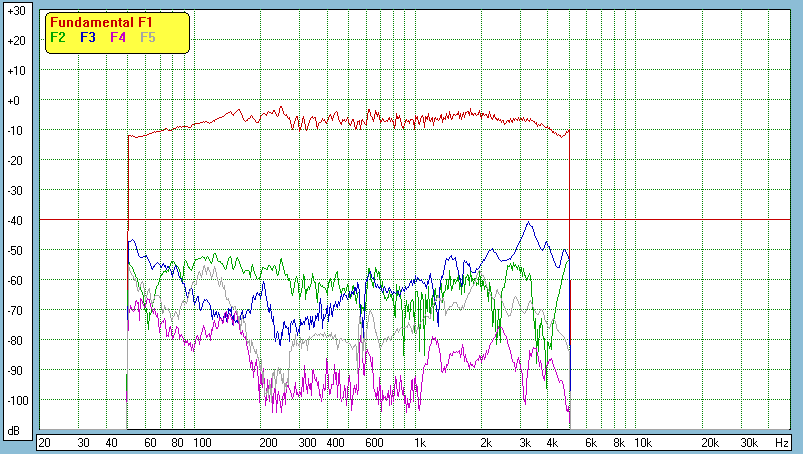
it seems that the second HD starts increasing from about 1KHz onwards, and peaks somewhere above 3KHz. If I apply an LR4 lowpass at 1.5KHz, I am down by about 24dB at 3KHz. It is about -45dB by itself on the naked driver, and another 24dB of cut will bring it down to the -70dB region. Maybe that's good enough?
If I have to do better than this with a 3-way, where I need to bring a reasonable tweeter in at some reasonable xo above the mid-bass, and I need to stick to metal cones for reasons I have mentioned earlier on my site and elsewhere, then I guess I'll need a wide-range low-distortion driver, something like the Jordans. Don't know what else will do. The conventional Seas Excel type metal cones will be all as bad as the RS150. Maybe the Zaph metal-cone driver too will be an excellent option, at a small fraction of the price of the Jordans.
But the RS150 I am using has quite severe breakup. The RS series mid-bass drivers all have them.Not all metal cone drivers have breakup or distortion peaking. Most large drivers intended for bass duty do, probably something to do with mass of the cone.
Last edited:
I intend to cross over at about 1.5K, 4th order electrical. Then, at about 3K, I intend to do another 4th order low-pass, thus making it 8th order from that point onwards. And then add some notch filters to target the sharp peaks in the SPL in the cone breakup region.
Have you modelled the electrical phase of the filter?
Am looking for them on Aliexpress. Thanks for pointing them out -- I had never heard of them.If 50w/ch is all you need try the TPA3116D2 boards. They sound fantastic at $20 ea and with simple mods for another $20 sound incredible. They are class D but don't hold that against them.
Over at Hifivision, someone had pointed me to 41hz. They too seem to have serious super-low-distortion Class D stuff. Any idea how good those are? Their site seems to have been down for many weeks now -- don't know what's going on with them. I have nothing against Class D, provided a few good DIYers who respect both measured and subjective tests give them the thumbs up.
Thanks -- very flattering.btw, I am following your thread with interest. Very nice speaker design and build. You are too modest about your design abilities - I have seen your blog, you know what you are doing
I had modelled both SPL and phase of my active filters when I was trying to mimic the passive xo of the Natalie P, and I had been able to get the phase pretty close to the passive xo. Jon Marsh had agreed. (Unfortunately, I have lost the image files which showed the SPL, phase, and the circuit itself.)Have you modelled the electrical phase of the filter?
For the Darbari, I have not modelled anything -- I am yet to fit the drivers, let alone take measurements. But I intend to try this approach and see where I land. A simple 4th order high-pass for the tweeter and this sequence of filters for the low-pass.
- Status
- This old topic is closed. If you want to reopen this topic, contact a moderator using the "Report Post" button.
- Home
- Loudspeakers
- Multi-Way
- The Darbari: new speaker project
